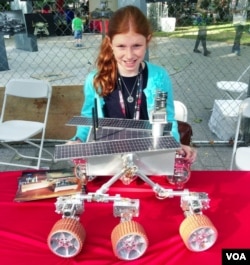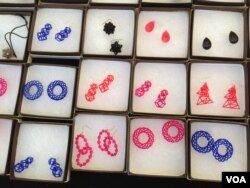QUEENS, NEW YORK —
Whether it is knitting a sweater, painting a picture, designing a computer program or fashioning a new artificial heart valve, the desire to make stuff seems to be a hardwired human trait. The spirit of making in all its forms is what the “Maker Faire" celebration, held every year in scores of locations worldwide, is all about.
With its hectares of colorful demonstration tables, hands-on exhibits, science-based games, performance stages and ad hoc “play islands,” the Maker Faire in Queens is equal parts festival, open air university and makeshift community, albeit one with a decidedly scientific bent.
Genevieve Beatty, 11, her sister Camille, 13, and her father Robert stand proudly next to a robot model of the Mars Lander, about a meter-and-a-half high, that Genevieve says they built themselves.
"Most of the ones that we built roll, like they have wheels, and some crawl and a few fly. It is just fun to work with my dad and my sister," she said. "I do all the inside, the electronics and soldering and stuff like that."
Genevieve’s father Robert notes that his other daughter, Camille, had a natural interest in mechanical things. She would take apart household appliances to understand how they worked. The three began assembling items with transistors and LED lights. Before long, the two girls asked to build a robot.
“... And that was pretty scary, but I thought okay if we really do a lot of research we will be able to figure out how to do it," said Beatty. "So we just started learning on YouTube and various website and trying to construct a little robot.""
In two years, the family has made nearly 35 robots, including several that were commissioned by science museums. But the main point, says Beatty is fun, family and education.
“I often do not know the subject of what we are trying to learn, but we learn it together, or I teach it to them and they do all the work," he said. "And that way they stay super engaged. As soon as I take over and try to do it myself, that is boring, and they go off and do something else. The key is to get them to do the work themselves.”
Hobby machinist, Dave Seff, likes to do his making strictly solo. His “plasma cutting torch” cuts a piece of steel about 13 millimeters thick into a sign for his business.
“I can take a jpeg, any kind of image from Photoshop, as long as it is a black and white high contrast image, and I can take a silhouette from that, I have a piece of software that can then turn that into coordinates that tells the machine where to go in space to turn on and off the torch to actually cut each one of these little pieces out,” he said.
Three-dimensional printing was one of the most popular areas of this year’s Maker Faire. At one booth, a young designer named Todd Blatt sold uniquely shaped day-glo jewelry he made with software, nylon powder and know how.
“I focused on designs that could not be made with traditional manufacturing methods," he said. "So I have things that are linked together with no seams and metal pieces that are [three-dimensionally] printed in shapes that you could not make molds out of. So it is really exciting to make these things that could not exist otherwise.”
Blatt’s process seems straightforward if not simple. He draws the object he wants in using computer software, and sends it to a three-dimensional printer, that melts nylon powder with a laser and “grows” the physical object one ultra-thin layer at a time.
“You can make products or you can make jewelry and movie prop replicas and clothing accessories - anything you want,” he said.
Not everyone here is high-tech. At a table manned by the Brooklyn-based “Fixer’s Collective,” Vincent Lai has just shown people how to repair a toaster and rewire a lamp, and is on to a vintage HP computer tablet with a cracked screen.
“And we feel very comfortable being here because we also believe that fixing and repair is a strong part of the making process," he said. "Because as you create, and as you shape, and as you whittle and scrape, you are going to run into roadblocks. And that is where your fixing skills need to come into play. So we want to emphasize that part of the making process. Spiritually speaking, a lot of people have been drifting away from ‘hands on.’ We want to bring that ‘handedness’ back ...”
There are too many offerings to savor at the Maker Faire, hundreds of delights - from rocketry to crochet, ham radio and bio-tech. One thing is clear, the spirit of making, in all its all-too-human variety, is alive and well here and at scores of other Maker Faires worldwide.
With its hectares of colorful demonstration tables, hands-on exhibits, science-based games, performance stages and ad hoc “play islands,” the Maker Faire in Queens is equal parts festival, open air university and makeshift community, albeit one with a decidedly scientific bent.
Genevieve Beatty, 11, her sister Camille, 13, and her father Robert stand proudly next to a robot model of the Mars Lander, about a meter-and-a-half high, that Genevieve says they built themselves.
"Most of the ones that we built roll, like they have wheels, and some crawl and a few fly. It is just fun to work with my dad and my sister," she said. "I do all the inside, the electronics and soldering and stuff like that."
Genevieve’s father Robert notes that his other daughter, Camille, had a natural interest in mechanical things. She would take apart household appliances to understand how they worked. The three began assembling items with transistors and LED lights. Before long, the two girls asked to build a robot.
“... And that was pretty scary, but I thought okay if we really do a lot of research we will be able to figure out how to do it," said Beatty. "So we just started learning on YouTube and various website and trying to construct a little robot.""
In two years, the family has made nearly 35 robots, including several that were commissioned by science museums. But the main point, says Beatty is fun, family and education.
“I often do not know the subject of what we are trying to learn, but we learn it together, or I teach it to them and they do all the work," he said. "And that way they stay super engaged. As soon as I take over and try to do it myself, that is boring, and they go off and do something else. The key is to get them to do the work themselves.”
Hobby machinist, Dave Seff, likes to do his making strictly solo. His “plasma cutting torch” cuts a piece of steel about 13 millimeters thick into a sign for his business.
“I can take a jpeg, any kind of image from Photoshop, as long as it is a black and white high contrast image, and I can take a silhouette from that, I have a piece of software that can then turn that into coordinates that tells the machine where to go in space to turn on and off the torch to actually cut each one of these little pieces out,” he said.
Three-dimensional printing was one of the most popular areas of this year’s Maker Faire. At one booth, a young designer named Todd Blatt sold uniquely shaped day-glo jewelry he made with software, nylon powder and know how.
“I focused on designs that could not be made with traditional manufacturing methods," he said. "So I have things that are linked together with no seams and metal pieces that are [three-dimensionally] printed in shapes that you could not make molds out of. So it is really exciting to make these things that could not exist otherwise.”
Blatt’s process seems straightforward if not simple. He draws the object he wants in using computer software, and sends it to a three-dimensional printer, that melts nylon powder with a laser and “grows” the physical object one ultra-thin layer at a time.
“You can make products or you can make jewelry and movie prop replicas and clothing accessories - anything you want,” he said.
Not everyone here is high-tech. At a table manned by the Brooklyn-based “Fixer’s Collective,” Vincent Lai has just shown people how to repair a toaster and rewire a lamp, and is on to a vintage HP computer tablet with a cracked screen.
“And we feel very comfortable being here because we also believe that fixing and repair is a strong part of the making process," he said. "Because as you create, and as you shape, and as you whittle and scrape, you are going to run into roadblocks. And that is where your fixing skills need to come into play. So we want to emphasize that part of the making process. Spiritually speaking, a lot of people have been drifting away from ‘hands on.’ We want to bring that ‘handedness’ back ...”
There are too many offerings to savor at the Maker Faire, hundreds of delights - from rocketry to crochet, ham radio and bio-tech. One thing is clear, the spirit of making, in all its all-too-human variety, is alive and well here and at scores of other Maker Faires worldwide.


